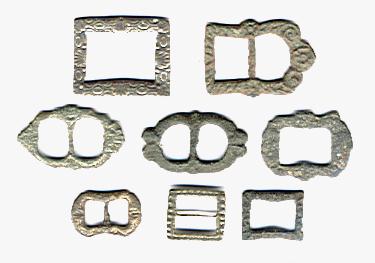|
|
|
Buckles have been in use for at least 2000 years. They range in style from simple utilitarian examples made of brass and iron, to elaborate jewellery items in precious metals set with gemstones.
The earliest buckles to be found in Britain have come from Late Iron Age contexts, and are probably of Roman origin. The Roman use of buckles seems to have been mainly confined to military uniform or civilian regalia. They are certainly not common finds. Throughout the roman period little evidence exists for the use of Buckles on horse harness, suggesting that as in previous centuries, alternative methods of fixing straps must have been employed. There are a considerable number of looped fittings such as terrets and other devices known from the Iron Age and Roman periods, and some of these may well have been used for securing straps by means of looping them back on themselves and tensioning them. Any precise dividing line between the Roman and Saxon buckles is impossible to establish, and is in any case of little relevance. A significant number of artefacts that were once thought to be purely Saxon have now been shown to be late Roman. We know that the Roman state employed Germanic mercenaries, and their uniform styles may have had their origins in either culture. Many Saxon buckles have come from burials, and it is rarely possible to say if the occupants of these wearing their equipment under the aegis of Rome, or as followers of an independent Saxon warlord.
Buckles remain scarce throughout the Saxon period, and probably continued to be mainly worn by the warrior classes. Civilian fashions presumably had little use for them. The Saxon phase itself, like the preceding Roman one, has no clear-cut division with the next period of convenience. In the course of six hundred or so years that separate the Saxon advent from the Norman invasion, considerable inroads were made by Scandinavian cultural influences. Yet here also it is rarely possible to say if any specific items was ethnically purely "Viking", or Anglo-Saxon in the Scandinavian style. And 1066 brought no radical change in fashion or equipment. In consequence Saxon buckles, along with many other artefacts, could possibly date from well into the medieval period. The Middle Ages saw a considerable growth in the production of material goods, and an increasing population, coupled with affluence and changing fashions, caused the buckle to become a common artefact. Many distinctive styles developed, although others remained basically unchanged throughout the period. The same holds true of subsequent ages, but future research, particularly that involving shipwreck and colonial archaeology, may help narrow things down further. Buckles from the 19th century onwards tend to be generally unremarkable in style. A few such as some military and harness types are distinctive, but in general the study of buckles as diagnostic historical artefacts ceases to have much relevance once the Victorian period is reached.
Jacobean Shoe Buckle |
|
Silver Buckle Plate |
 |
|||
Various 18th Century Buckles |
Various 17th Century Buckles |
12-13th
Century Mount |
The Find Pages And Other Links